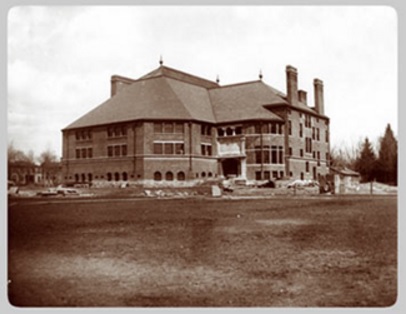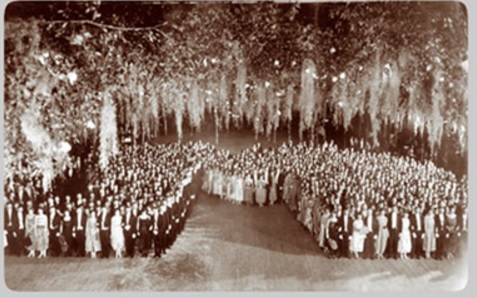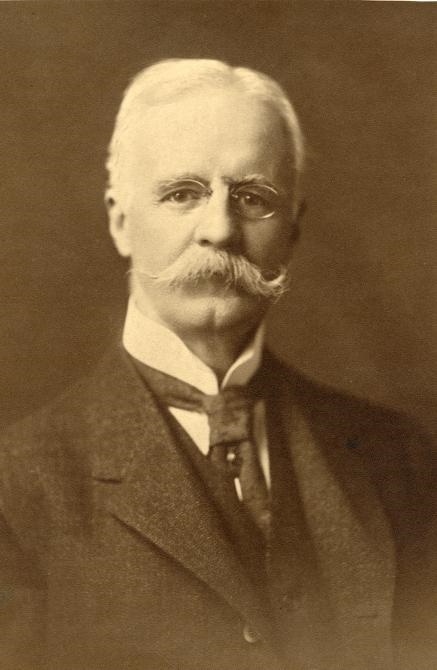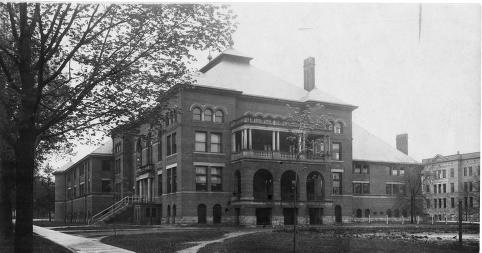Waterman Gymnasium
It’s time to work out a history of this space
As early as 1878, University students began to express interest in having a space on campus for recreational use apart from the official varsity athletic spaces (Wear 1950). With the support of a number of donations and in spite of the Depression of 1893, the Waterman Gymnasium was completed 1894 for a cost of about $50,000. One of the most significant donations (about half of the total funds raised) came from Joshua Waterman of Detroit, the building’s namesake (Wear 1950). Originally erected on the northeast corner of the original campus boundary, today the site is occupied by the University’s Chemistry Building.

The Waterman Gymnasium
Over the years, the facility was used for a variety of student activities such as exercise classes, class registration, a dance hall, a space for fundraising banquets and a space for barrack-like training for World War I soldiers (Angell 1909). With the rise of female enrollment at the University in the late ninteenth century, debates arose regarding whether or not there should be a recreational space for women to use or if men and women should be permitted to use the building simultaneously. Contemporary sources indicate that there was not sufficient money to build separate facilities for men and women the previous decade due to the economic downturn of 1893 which is why only one building, the Waterman Gym was built (Wear 1950).

Students attend a ‘J-Hop’ dance at the Waterman Gymnasium.
The debate settled years later, leading to the construction of the Barbour Gymnasium (1902). Seven years earlier, Barbour Gymnasium’s namesake, University Regent Levi Barbour of Detroit, donated several properties in Detroit to the University ([Levi L. Barbour Papers] 1857). While initially intended to be used for arts education, the University administration ultimately decided to sell the properties and use the funds to construct Barbour Gym amid growing tensions by women across the country for equal treatment. The University sought to take an active, responsible role in the accomodation of female students and their experiences by establishing their first Dean of Women in 1896, Eliza Mosher and adjusting their admission policies to allow women to enroll ([Eliza Maria Mosher Papers 1846-1935]).
Constructed side by side, the Barbour Gym stood to the north of the Waterman Gym. Significant funding for the Barbour Gymnasium was provided by the Women’s League of the University as the new space was intended for women’s use ([Levi L. Barbour Papers] 1857). The Women’s League of the University was also responsible for the construction of the Michigan League in 1921, a response to the construction of the Michigan Union, a commissary area for men only, in 1919. In addition to physical education, the Barbour Gymnasium was also used for social events and theater performances (Angell 1909; Wear 1950).

Levi Barbour
As time went on and the University continued to expand, particularly to the south, the Waterman and Barbour Gymnasium began to be considered obsolete. As early at 1916, the administration and students alike began to favor recreational facilities to the south, notably Ferry Field and the Intramural Sports Building on Hoover Street, for their more updated infrastructure (Wear 1950).

Barbour Gymnasium
With time, the University appeared to shift its focus for the campus: the original campus boundary would be for academic buildings while facilities to the south would be designated for all athletic and recreational activities. Due to shifting needs, the University demolished the Barbour Gymnasium in 1946 and the Waterman Gymnasium in 1977 (“Barbour Gymnasium”). While the latter came down to make way for the University’s Chemistry building, it is curious to consider the trajectory of these two buildings from an urban planning perspective. While it is impossible to predict the future entirely, it is thought-provoking to think through the University’s handling of the properties. For instance, Barbour Gymnasium was bulldozed nearly forty years after it was first built and had fallen into disrepair barely ten years into operation. Did the Barbour Gymnasium fall out of favor due to the vanishing differences between men and women in terms of divided facilities or were funds simply allocated elsewhere, perhaps for academic pursuits rather than athletic endeavors?
To conclude, the emerging contentious dichotomy between academics and athletics can perhaps be complicated by the writings of University Regent and donor for the Barbour Gymnasium, Levi Barbour. Barbour, in his book, “College Training for Professional Men”, writes, ‘Discipline is the immediate and principal method and object of college work; not the learning of facts so much as the training of the mind, and in recent years, training of the body also; to act regularly, strongly and effectively on the task in hand - whether it be research, argument, or a contest of strength and endurance” (Barbour 1898, 5). Barbour appears to indicate that one must remain fit in mind and body in order to an optimal contributor to society. The implications of works like this continue to emanate in universities’ plans across the country.
Sources
- Angell, J. Burrill. “Farewell address of President James Burrill Angell to the undergraduate students of the University of Michigan, Waterman gymnasium, May the twenty-eighth”, 1909. [Ann Arbor, Mich.: Ann Arbor Press.]
- Barbour, Levi L. [Levi L. Barbour Papers], 1857. The Bentley Historical Library. University of Michigan.
- Barbour, Levi L. “College Training for Professional Men.” Lansing, Mich.: R. Smith print. co., 1897.
- “Barbour Gymnasium.” The University of Michigan Millennium Project. http://umhistory.dc.umich.edu/mort/original/1900/20%20Barbour%20Gymnasium/index.html
- Mosher, Eliza Maria. “Eliza Maria Mosher Papers 1846-1934.” The Bentley Historical Library. University of Michigan.
- “Waterman Gymnasiums.” The University of Michigan Millennium Project. http://umhistory.dc.umich.edu/mort/original/1900/19%20Waterman%20Gymnasium/index.html
- Wear, Robert E. “University of Michigan’s Waterman Gymnasium : development and expansion from 1894 to 1930.”, 1950. Call number 861152 Aa 1
Image credits
-
“Waterman Gymnasiums.” The University of Michigan Millennium Project. http://umhistory.dc.umich.edu/mort/original/1900/19%20Waterman%20Gymnasium/index.html
-
“Barbour Gymnasium-from distance; HS8110.” The Bentley Historical Library. University of Michigan. http://quod.lib.umich.edu/b/bhl/x-hs8110/HS8110?from=index;lasttype=boolean;lastview=thumbnail;med=1;resnum=15;size=20;sort=relevance;start=1;subview=detail;view=entry;rgn1=ic_all;q1=barbour+gymnasium
-
“Levi Barbour, portrait; HS1359” The Bentley Historical Library. University of Michigan. http://quod.lib.umich.edu/b/bhl/x-hs1359/HS1359?from=index;lasttype=boolean;lastview=thumbnail;med=1;resnum=2;size=20;sort=relevance;start=1;subview=detail;view=entry;rgn1=ic_all;q1=levi+barbour